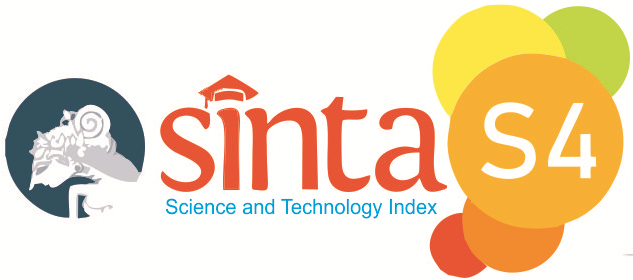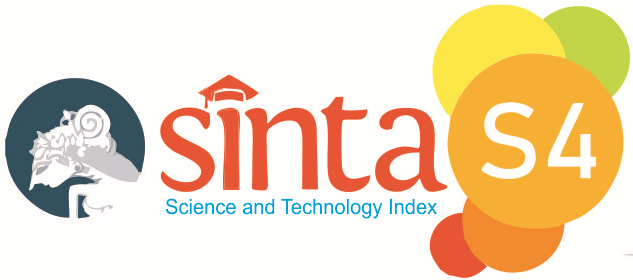Problem based learning with geogebra: Impact on mathematical communication skills and mathematical problem solving
DOI:
https://doi.org/10.32332/8g8bjr06Abstract
Students' mathematical communication and mathematical problem solving are still weak because the average test results are still below the KKM. Seeing this, the author conducted a study using the Problem Based Learning learning model. The goal is for students to be able to solve a mathematical problem properly and correctly. This study uses a quantitative approach with a quasi-experimental research type with a post-test only control group research design. The sample in this study were students in grades XI IPA I and XI IPA 2 with a simple random sampling technique. The data collection technique in this study was a test. The prerequisite techniques used were multivariate normality and homogeneity tests and hypothesis testing in this study used the Multivariate Analysis Of Variance (Manova) test. The results of the study showed that there was an influence of the GeoGebra-assisted Problem Based Learning approach on the mathematical communication and mathematical problem solving abilities of high school students and on the mathematical communication and mathematical problem solving abilities of students, there was a better influence of the GeoGebra-assisted Problem Based Learning learning model compared to conventional learning models.
References
Aini, Netriwati, L. (2019). Metode Penelitian. CV IRDH.
Andini, D., Mulyani, N., Wijaya, T. T., & Supriyati, D. N. (2019). Meningkatkan Kemampuan Komunikasi Matematis Dan Self Confidence Siswa Menggunakan Pendekatan PBL Berbantuan Geogebra. Jurnal Derivat: Jurnal Matematika Dan Pendidikan Matematika, 5(1), 82–93. https://doi.org/10.31316/j.derivat.v5i1.150
Dahlan, J., Indonesia, U. P., & Kusumah, Y. S. (2011). Pengembangan Model Computer-Based E-Learning untuk meningkatkan kemampuan High Order Mathematical Thinking. March 2016. https://doi.org/10.18269/jpmipa.v16i2.222
Kusuma, R. D. F. D., Nasution, S. P., & Anggoro, B. S. (2018). Multimedia Pembelajaran Matematika Interaktif Berbasis Komputer. Desimal: Jurnal Matematika, 1(2), 191. https://doi.org/10.24042/djm.v1i2.2557
Lestari, D. D., Ansori, I., & Karyadi, B. (2017). Penerapan Model Pbm Untuk Meningkatkan Kinerja Dan Kemampuan Berpikir Kritis Siswa Sma. Diklabio: Jurnal Pendidikan Dan Pembelajaran Biologi, 1(1), 45–53. https://doi.org/10.33369/diklabio.1.1.45-53
Mariam, S., Nurmala, N., Nurdianti, D., Rustyani, N., Desi, A., & Hidayat, W. (2019). Analisis Kemampuan Pemecahan Masalah Matematis Siswa MTsN Dengan Menggunakan Metode Open Ended Di Bandung Barat. Jurnal Cendekia : Jurnal Pendidikan Matematika, 3(1), 178–186. https://doi.org/10.31004/cendekia.v3i1.94
Nuraeni, R., & Luritawaty, I. P. (2018). Mengembangkan Kemampuan Komunikasi Matematik Siswa melalui Strategi Think Talk Write. Mosharafa: Jurnal Pendidikan Matematika, 5(2), 101–112. https://doi.org/10.31980/mosharafa.v5i2.265
P. Purwanto, R. A. (2020). Kamu Kepo tentang Problem Based Learning (PBL) dan Objective Structured Student Oral Case Analysis (OSOCA). ITB Press.
Pendidikan, I. (n.d.). Buku_Diktat_Yahya.
Purwanti, R. D., Pratiwi, D. D., & Rinaldi, A. (2016). Pengaruh Pembelajaran Berbatuan Geogebra terhadap Pemahaman Konsep Matematis ditinjau dari Gaya Kognitif. Al-Jabar : Jurnal Pendidikan Matematika, 7(1), 115–122. https://doi.org/10.24042/ajpm.v7i1.131
Rahadyan, A., Hartuti, P. M., & Awaludin, A. A. R. (2018). Penggunaan Aplikasi Geogebra dalam Pembelajaran Matematika di Sekolah Menengah Pertama. Jurnal PkM Pengabdian Kepada Masyarakat, 1(01), 11. https://doi.org/10.30998/jurnalpkm.v1i01.2356
Rahmat, A. (2013). Pengantar Pendidikan Teori, Konsep, dan aplikasi. Ideas Publishing, 1–159.
Siregar, N. F. (2018). Komunikasi Matematis Dalam Pembelajaran Matematika. Logaritma: Jurnal Ilmu-Ilmu Pendidikan Dan Sains, 6(02), 74. https://doi.org/10.24952/logaritma.v6i02.1275
Sugiarni, R., Alghifari, E., & Ifanda, A. R. (2018). Meningkatkan Kemampuan Spasial Matematis Siswa Dengan Model Pembelajaran Problem Based Learning Berbantuan Geogebra. KALAMATIKA Jurnal Pendidikan Matematika, 3(1), 93–102. https://doi.org/10.22236/kalamatika.vol3no1.2018pp93-102
Taniredja, T., Faridli, E. M., & Harmianto, S. (2011). Finish.Pdf. In Model-Model Pembelajaran Inovatif (p. 128).
Wardhani, A. K., Haerudin, & Ramlah. (2022). Analisis Kemampuan Pemecahan Masalah Matematis Siswa dalam Menyelesaikan Soal TIMSS Materi Geometri. Didactical Mathematics, 4(1), 94–103. https://doi.org/10.31949/dm.v4i1.2017
Yudhanegara, K. E. L. and M. R. (2015). Penelitian Pendidikan Matematika. Refika Aditama.
Downloads
Published
Issue
Section
License
Copyright (c) 2025 Eva Amallya, Bambang Sri Anggoro, Abi Fadila

This work is licensed under a Creative Commons Attribution-ShareAlike 4.0 International License.

















